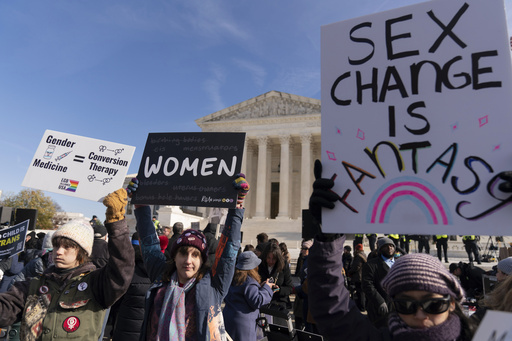Public health information vanished from various federal agency websites, some pages turned blank, and government employees eliminated pronouns from their email signatures on Friday, as authorities hurried to adhere to a directive associated with President Donald Trump’s recent order that rolled back protections for transgender individuals.
The Office of Personnel Management issued a memo on Wednesday directing agency leaders to eliminate references to “gender ideology” from their websites, emails, and contracts, requiring these alterations to be completed by 5 p.m. on Friday. Additionally, the memo called for the disbanding of employee resource groups, the termination of grants and contracts relevant to these issues, and an instruction to change the term “gender” to “sex” on government paperwork.
Several government websites displayed the message “The page you’re looking for does not exist,” with some content disappearing and reappearing unpredictably throughout the day. When asked by reporters about claims that government sites were being shut down to erase references to diversity, equity, and inclusion, Trump stated he was unaware of the situation but would support such an action. “I don’t know. That doesn’t sound like a bad idea to me,” Trump remarked, emphasizing that he campaigned with a pledge to abolish such initiatives.
Substantial public health resources were removed from the Centers for Disease Control and Prevention (CDC) website, including guidelines on contraception, information regarding HIV and transgender individuals, educational materials about fostering supportive school environments for transgender and nonbinary youths, details about National Transgender HIV Testing Day, and surveys indicating increased rates of depression, substance use, bullying, and other challenges faced by transgender students.
Experts in health and disease remarked that the removal of these resources creates hazardous voids in essential scientific information. Leaders from the Infectious Diseases Society of America, a professional medical association, condemned the withdrawal of information concerning HIV and transgender people, stating that access to such data is crucial for efforts aimed at combating the HIV epidemic.
A page previously labeled “Inmate Gender” on the Bureau of Prisons website was renamed to “Inmate Sex” on that same day, and details about transgender inmates in federal facilities were omitted. Furthermore, the State Department removed the option for nonbinary applicants to select “X” as a gender on passport applications, replacing the term “gender” with “sex.” However, the online passport application became temporarily unavailable, displaying a notice regarding system maintenance.
All State Department personnel received orders to eliminate gender-specific pronouns from their email signatures as part of compliance with Trump’s executive orders. This mandate, issued by the acting head of the Bureau of Management, explicitly called for all employees to make these changes by the specified deadline and stressed the importance of cooperation during these adjustments.
An official from the U.S. Agency for International Development (USAID) indicated that staff were required to mark the occurrence of the word “gender” in a multitude of award contracts. Gender discrimination warnings, which are common in many contracts, faced scrutiny under these new dictates. The official, speaking anonymously out of concern for retaliation, noted apprehension regarding the targeting of programs and employment related to inclusion, gender issues, and those focused on women’s interests under two executive orders from the Trump administration.
Several pages from the Census Bureau and National Park Service also experienced access issues, leading to error messages. Trump’s executive order, signed as he returned to office, instructs the federal government to define sex strictly as male or female, ensuring this classification is applied in official documents such as passports as well as in federal prison policies.
On the eve of Black History Month, Defense Secretary Pete Hegseth directed the military to immediately cease the recognition of identity, suggesting that such events could undermine camaraderie and impair mission capabilities.


